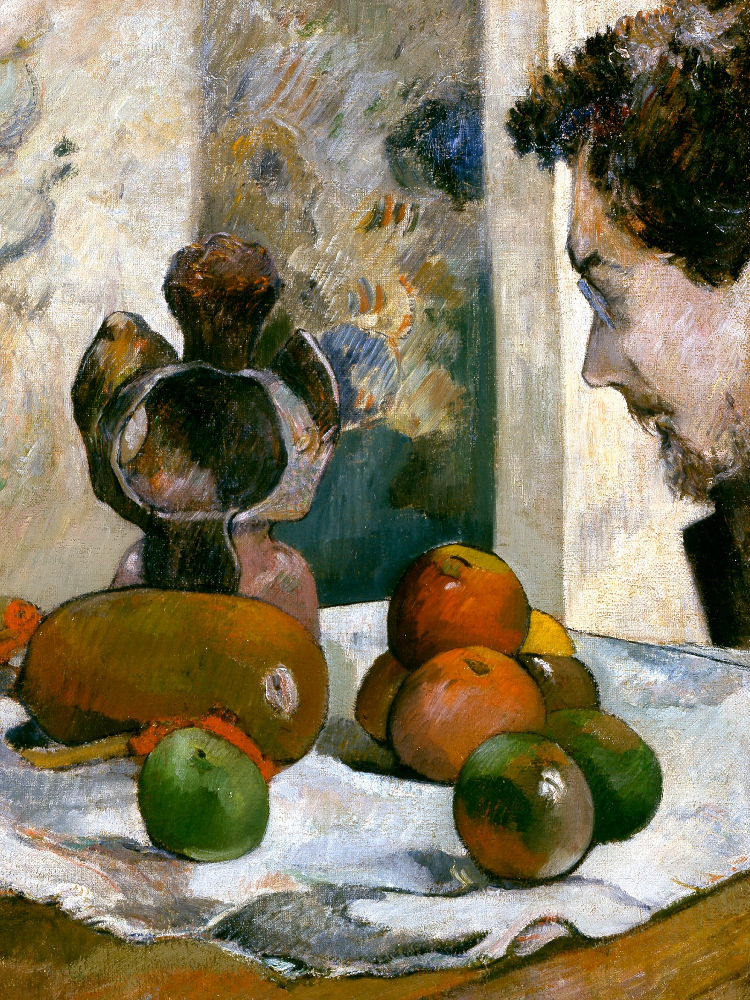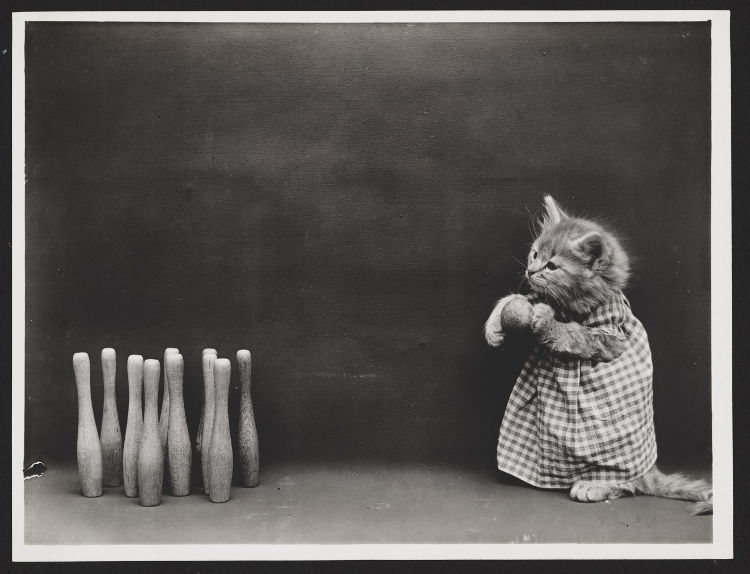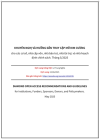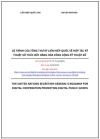
Implementing Open Access in GLAMs
Anne Young, Feb 18 · 4 min read
Theo: https://medium.com/open-glam/implementing-open-access-in-glams-3bda60941188
Bài được đưa lên Internet ngày: 18/02/2020
Trong loạt bài đầu tiên của cô (các bài đăng đầu tiên (bản dịch tiếng Việt), thứ hai (bản dịch tiếng Việt), thứ ba (bản dịch tiếng Việt) và thứ tư (bản dịch tiếng Việt), Anne Young đã đề cập tới những điều cơ bản của các quyền và tái tạo lại mà là nền tảng cho việc xúc tác cho Truy cập Mở. Trong loạt thứ hai này, cô sẽ tập trung vào Truy cập Mở là gì, vì sao nó là điều tốt lành, và phác họa các lựa chọn triển khai khác nhau cho các cơ sở GLAM.
1. Truy cập Mở là gì?

Still Life with Profile of Laval (chi tiết), 1886, dầu trên vải bố, 18–1/8 x 15 in. Viện bảo tàng Nghệ thuật Indianapolis ở Newfields, Bộ sự tập Samuel Josefowitz Collection của Trường Pont-Aven, thông qua sự hào phóng của Lilly Endowment Inc., gia đình Josefowitz, Ông và Bà Leonard J. Betley, Lori và Dan Efroymson, và những người bạn khác của viện bảo tàng, 1998.167. Phạm vi công cộng .
Việc xác định Truy cập Mở nhất thiết liên quan tới việc xác định sự đa dạng các điều khoản được sử dụng để mô tả “mở” bao gồm không chỉ Truy cập Mở, mà còn cả Nội dung Mở, Dữ liệu Mở, và Nguồn Mở. Truy cập Mở thường được sử dụng như là khái niệm bao trùm xoay quanh nhiều/tất cả các dạng “mở”. Hãy xem nhanh bức tranh đó:
Định nghĩa truyền thống xác định Truy cập Mở như là “thực hành cung cấp truy cập không có hạn chế qua Internet tới các bài báo trên tạp chí học thuật được rà soát lại ngang hàng. Truy cập Mở cũng ngày cngf được cung ấp cho các luận án, các sách chuyên khảo học thuật, và các chương sách”. Trong kịch bản này, Truy cập Mở tới ở 2 mức độ:
Truy cập Mở không mất tiền - Gratis Open Access: truy cập trên trực tuyến không có chi phí.
Truy cập Mở tự do - Libre Open Access: Truy cập Mở không mất tiền cộng với một vài quyền sử dụng bổ sung1.
Trong vài trường hợp, Truy cập Mở đầy đủ, hoặc Nội dung Mở, cũng bao gồm quyền sửa đổi tác phẩm, trong khi trong xuất bản học thuật thường giữ nguyên nội dung bài báo và liên kết nó với tác giả hoặc nhóm các tác giả cố định.
Truy cập Mở, Nội dung Mở, Nguồn Mở, và các biến thể khác về chủ đề “mở” đang ngày càng áp đảo trong các cơ sở GLAM đang nỗ lực cung cấp truy cập công khai rộng rãi hơn tới các tư liệu bộ sưu tập của họ. Và có những lý do quan trọng để ủng hộ quyết định này:
cho phép những người sử dụng sửa đổi một cách sáng tạo các tác phẩm và phân phối các bản sao các sửa đổi của họ;
xúc tác cho Dữ liệu Mở Liên kết cho các thư viện, kho lưu trữ và viện bảo tàng - LODLAM (Linked Open Data for Libraries, Archives and Museums) để kết nối dữ liệu có liên quan để cho phép những thấu hiểu mới có ý nghĩa trong nghiên cứu và phát hiện nội dung;
phát triển và thúc đẩy các tiêu chuẩn tương hợp để tạo thuận lợi cho phổ biến nội dung hiệu quả2.
Tất cả chúng cùng nhau làm việc để mở rộng và thúc đẩy truy cập rộng rãi tới các tài nguyên số.

Ten pins, khoảng 1914, ảnh in. Bộ phận In ấn và Ảnh chụp của Thư viện Quốc hội, LC-DIG-ds-04042. Phạm vi công cộng.
Được trang bị với các định nghĩa đó, các chuyên gia R&R của các cơ sở GLAM có thể bắt đầu đánh giá mức độ Truy cập Mở nào (được sử dụng như là khái niệm bao quanh tất cả ở đây) có thể phù hợp nhất cho các nhu cầu các mục tiêu và sứ mệnh cơ sở của họ.
Trong khi sự áp dụng chính sách Truy cập Mở chính thức (tôi khuyến cáo cao độ chính sách đó như là một phần của chính sách sở hữu trí tuệ tổng thể của một cơ sở GLAM), hoặc sự giới thiệu các tệp ảnh và video Truy cập Mở hoặc Nội dung Mở được cung cấp trực tiếp từ website của một GLAM đang tăng trưởng về số lượng, có vài sự không nhất quán trong việc cung cấp và định dạng mà các chuyên gia R&R nên nhận thức được khi tìm cách sử dụng lại nội dung.
Vì thế, là đáng giá xem xét thận trọng liệu bộ sưu tập có thực sự là “mở” hay không. Vài cơ sở GLAM sử dụng ngôn ngữ như “tự do” và “mở” để mô tả các bộ sưu tập sẵn sàng công khai trong khi cùng lúc áp đặt các hạn chế lên sử dụng. Các thực hành đó là những gì tôi và những người chuyên nghiệp của các GLAM khác thường mô tả như là “Truy cập Mở nửa vời” (Semi-Open Access), “Không Truy cập Mở” (NOpen Access), hoặc “Không GLAM Mở” (NopenGLAM).
Tuy nhiên, đừng lo! Thậm chí với những thứ không nhất quán như vậy xung quanh “mở”, tin tốt lành là số lượng đang gia tăng các cơ sở GLAM đang ôm lấy Truy cập Mở, và có các công cụ sẵn sàng cho các chuyên gia R&R khi họ giúp hướng dẫn các cơ sở của họ.
Trong bài đăng tiếp sau, chúng tôi sẽ khai phá các công cụ và chương trình mà các những người chuyên nghiệp GLAM có thể sử dụng để tích hợp Truy cập Mở vào cơ sở của họ.
Khước từ: Nội dung của bài đăng này không cấu thành sự tư vấn pháp lý và cũng không tham chiếu tới bất kỳ tình huống đặc biệt hay đặc thù nào. Nếu bạn có bất kỳ sự nghi ngờ nào về tình huống đặc thù của bạn, bạn nên tư vấn với luật sư.
Các bài đăng đã được biên tập ngoài tập hợp các đoạn tweet mà Anne đã làm trong quá trình giám tuyển của cô đối với tài khoản Twitter @openglam. Hãy nhớ là bạn cũng có thể làm điều đó, hãy đăng ký ở đây!
Anne Young là Giám đốc các công việc pháp lý và sở hữu trí tuệ ở Newfields và là người biên tập “Các quyền và tái tạo lại: Sổ tay cho các cơ sở văn hóa, ấn bản lần hai”, vì nó mà bà đã nhận được giải thưởng Nancy DeLaurier của Hiệp hội Tài nguyên Nhìn vào năm 2017.
Chú giải
[1] Megan P. Bryant, Cherie C. Chen, Kenneth D. Crews, John ffrench, Walter G. Lehmann, Naomi Leibowitz, Melissa Levine, Sofía Galarza Liu, Michelle Gallagher Roberts, Nancy Sims, Deborah Wythe and Anne M. Young, Rights and Reproductions: The Handbook for Cultural Institutions, Second Edition. Edited by Anne M. Young. Lanham, Maryland: Rowman and Littlefield, 2019, p. 349.
Giữ lại một số quyền CC BY-NC
In her first series (post one, two, three, four) Anne Young covered the essentials of rights and reproductions that are fundamental to enabling Open Access. In this second series, she’ll focus on what Open Access is, why it’s a good thing, and outline various implementation options for GLAM institutions.
1. What is Open Access, anyway?
Still Life with Profile of Laval (detail), 1886, oil on canvas, 18–1/8 x 15 in. Inianapolis Museum of Art at Newfields, Samuel Josefowitz Collection of the School of Pont-Aven, through the generosity of Lilly Endowment Inc., the Josefowitz Family, Mr. and Mrs. Leonard J. Betley, Lori and Dan Efroymson, and other Friends of the Museum, 1998.167. Public Domain.
Defining Open Access necessarily involves defining the variety of terms used to describe “open” including not only Open Access, but also Open Content, Open Data, and Open Source. Open Access is often used as the overarching term to encompass many or all of these forms of “open.” Let’s take a quick look at the landscape:
The traditional definition defines Open Access as the “practice of providing unrestricted access via the internet to peer-reviewed scholarly journal articles. Open Access is also increasingly being provided to theses, scholarly monographs, and book chapters.” In this scenario, Open Access comes in two degrees:
In some cases, full Open Access, or Open Content, also includes the right to modify the work, whereas in scholarly publishing it is usual to keep an article’s content intact and to associate it with a fixed author or group of authors.
Open Access, Open Content, Open Source, and other variations on a theme of “open” are becoming more prevalent among GLAMs that are endeavoring to provide broader public access to their collection materials. And there are important reasons that back this decision:
allowing users to creatively modify works and distribute copies of their modifications;
enabling Linked Open Data for Libraries, Archives and Museums (LODLAM) to connect related data to allow for new meaningful insights in research and content discovery;
developing and promoting interoperability standards to facilitate the efficient dissemination of content.²
All these together work to expand and promote broad access to digital resources.Ten pins, about 1914, photographic print. Library of Congress Prints and Photographs Division, LC-DIG-ds-04042. Public Domain.
Armed with these definitions, GLAM R&R Specialists can begin to assess what level of Open Access (used as an all-encompassing term here) can best suit the needs of their institution’s goals and mission.
While the adoption of a formal Open Access policy (I highly recommend one as part of a GLAM’s overall Intellectual Property Policy), or the introduction of Open Access or Open Content image and video files provided directly from a GLAM’s website are growing in number, there are several inconsistencies in delivery and formatting that R&R Specialists should be aware of when seeking to reuse content.
Therefore, it is worth carefully examining whether a collection is truly “open.” Some GLAMs use language like “free” and “open” to describe publicly available collections whilst simultaneously imposing limitations on use. Those practices are what I and other GLAM professionals often describe as “Semi-Open Access,” “NOpen Access,” or “NOpenGLAM.”
However, do not fret! Even with such inconsistencies around “open,” the good news is that a growing number of GLAMs are embracing Open Access, and there are tools available to R&R Specialists as they help guide their institutions.
In the next post, we’ll explore tools and programs that GLAM professionals can use to integrate Open Access in their institution.
Disclaimer: The content of this post does not constitute legal advice nor does it refer to any particular or specific situation. If you have any doubts about your specific situation, you should consult with a lawyer.
These posts were compiled out of the set of tweets that Anne did during her curation of the @openglam Twitter account. Remember you can do it too, just sign up here!
Anne Young is the Director of Legal Affairs and Intellectual Property at Newfields and editor of “Rights and Reproductions: The Handbook for Cultural Institutions, Second Edition”, for which she received the Visual Resources Association’s Nancy DeLaurier Award in 2017.
Footnotes
[1] Megan P. Bryant, Cherie C. Chen, Kenneth D. Crews, John ffrench, Walter G. Lehmann, Naomi Leibowitz, Melissa Levine, Sofía Galarza Liu, Michelle Gallagher Roberts, Nancy Sims, Deborah Wythe and Anne M. Young, Rights and Reproductions: The Handbook for Cultural Institutions, Second Edition. Edited by Anne M. Young. Lanham, Maryland: Rowman and Littlefield, 2019, p. 349.
Some rights reserved CC BY-NC
Dịch: Lê Trung Nghĩa
Ý kiến bạn đọc
Những tin mới hơn
Những tin cũ hơn
Blog này được chuyển đổi từ http://blog.yahoo.com/letrungnghia trên Yahoo Blog sang sử dụng NukeViet sau khi Yahoo Blog đóng cửa tại Việt Nam ngày 17/01/2013.Kể từ ngày 07/02/2013, thông tin trên Blog được cập nhật tiếp tục trở lại với sự hỗ trợ kỹ thuật và đặt chỗ hosting của nhóm phát triển...
 DigComp 3.0: Khung năng lực số châu Âu
DigComp 3.0: Khung năng lực số châu Âu
 Các bài toàn văn trong năm 2025
Các bài toàn văn trong năm 2025
 Các bài trình chiếu trong năm 2025
Các bài trình chiếu trong năm 2025
 Các lớp tập huấn thực hành ‘Khai thác tài nguyên giáo dục mở’ tới hết năm 2025
Các lớp tập huấn thực hành ‘Khai thác tài nguyên giáo dục mở’ tới hết năm 2025
 Tập huấn thực hành ‘Khai thác tài nguyên giáo dục mở’ cho giáo viên phổ thông, bao gồm cả giáo viên tiểu học và mầm non tới hết năm 2025
Tập huấn thực hành ‘Khai thác tài nguyên giáo dục mở’ cho giáo viên phổ thông, bao gồm cả giáo viên tiểu học và mầm non tới hết năm 2025
 Các tài liệu dịch sang tiếng Việt tới hết năm 2025
Các tài liệu dịch sang tiếng Việt tới hết năm 2025
 Loạt bài về AI và AI Nguồn Mở: Công cụ AI; Dự án AI Nguồn Mở; LLM Nguồn Mở; Kỹ thuật lời nhắc;
Loạt bài về AI và AI Nguồn Mở: Công cụ AI; Dự án AI Nguồn Mở; LLM Nguồn Mở; Kỹ thuật lời nhắc;
 Tổng hợp các bài của Nhóm các Nhà cấp vốn Nghiên cứu Mở (ORFG) đã được dịch sang tiếng Việt
Tổng hợp các bài của Nhóm các Nhà cấp vốn Nghiên cứu Mở (ORFG) đã được dịch sang tiếng Việt
 Tổng hợp các bài của Liên minh S (cOAlition S) đã được dịch sang tiếng Việt
Tổng hợp các bài của Liên minh S (cOAlition S) đã được dịch sang tiếng Việt
 Năm Khoa học Mở & Chuyển đổi sang Khoa học Mở - Tổng hợp các bài liên quan
Năm Khoa học Mở & Chuyển đổi sang Khoa học Mở - Tổng hợp các bài liên quan
 Bạn cần biết những gì về các khung năng lực AI mới của UNESCO cho học sinh và giáo viên
Bạn cần biết những gì về các khung năng lực AI mới của UNESCO cho học sinh và giáo viên
 Khung năng lực AI cho giáo viên
Khung năng lực AI cho giáo viên
 Bàn về 'Lợi thế của doanh nghiệp Việt là dữ liệu Việt, bài toán Việt' - bài phát biểu của Bộ trưởng Nguyễn Mạnh Hùng ngày 21/08/2025
Bàn về 'Lợi thế của doanh nghiệp Việt là dữ liệu Việt, bài toán Việt' - bài phát biểu của Bộ trưởng Nguyễn Mạnh Hùng ngày 21/08/2025
 Ngày Phần mềm Tự do, Ngày Phần cứng tự do, Ngày Tài liệu Tự do
Ngày Phần mềm Tự do, Ngày Phần cứng tự do, Ngày Tài liệu Tự do
 ‘Khung năng lực AI cho giáo viên’ - bản dịch sang tiếng Việt
‘Khung năng lực AI cho giáo viên’ - bản dịch sang tiếng Việt
 Mark Zuckerberg: DeepSeek cho thấy vì sao nước Mỹ phải là ‘tiêu chuẩn nguồn mở toàn cầu’ của AI; không có lý do gì để suy nghĩ lại về việc chi tiêu
Mark Zuckerberg: DeepSeek cho thấy vì sao nước Mỹ phải là ‘tiêu chuẩn nguồn mở toàn cầu’ của AI; không có lý do gì để suy nghĩ lại về việc chi tiêu
 ‘KHUYẾN NGHỊ VÀ HƯỚNG DẪN TRUY CẬP MỞ KIM CƯƠNG cho các cơ sở, nhà cấp vốn, nhà bảo trợ, nhà tài trợ, và nhà hoạch định chính sách’ - bản dịch sang tiếng Việt
‘KHUYẾN NGHỊ VÀ HƯỚNG DẪN TRUY CẬP MỞ KIM CƯƠNG cho các cơ sở, nhà cấp vốn, nhà bảo trợ, nhà tài trợ, và nhà hoạch định chính sách’ - bản dịch sang tiếng Việt
 DeepSeek đã gây ra sự hoảng loạn trên thị trường — nhưng một số người cho rằng việc bán tháo là quá mức
DeepSeek đã gây ra sự hoảng loạn trên thị trường — nhưng một số người cho rằng việc bán tháo là quá mức
 50 công cụ AI tốt nhất cho năm 2025 (Đã thử và kiểm nghiệm)
50 công cụ AI tốt nhất cho năm 2025 (Đã thử và kiểm nghiệm)
 Nhà khoa học AI hàng đầu của Meta cho biết thành công của DeepSeek cho thấy 'các mô hình nguồn mở đang vượt trội hơn các mô hình độc quyền'
Nhà khoa học AI hàng đầu của Meta cho biết thành công của DeepSeek cho thấy 'các mô hình nguồn mở đang vượt trội hơn các mô hình độc quyền'
 “Chúng tôi không có hào nước”: Sự đổi mới đột phá của AI nguồn mở
“Chúng tôi không có hào nước”: Sự đổi mới đột phá của AI nguồn mở
 UNESCO dành Ngày Giáo dục Quốc tế 2025 cho Trí tuệ nhân tạo
UNESCO dành Ngày Giáo dục Quốc tế 2025 cho Trí tuệ nhân tạo
 ‘Đặc tả Khung Tính mở Mô hình (MOF)’ của LF AI & Data - Tài sản chung của AI Tạo sinh - bản dịch sang tiếng Việt
‘Đặc tả Khung Tính mở Mô hình (MOF)’ của LF AI & Data - Tài sản chung của AI Tạo sinh - bản dịch sang tiếng Việt
 ‘LỘ TRÌNH CỦA TỔNG THƯ KÝ LIÊN HIỆP QUỐC VỀ HỢP TÁC KỸ THUẬT SỐ THÚC ĐẨY HÀNG HÓA CÔNG CỘNG KỸ THUẬT SỐ’ - bản dịch sang tiếng Việt
‘LỘ TRÌNH CỦA TỔNG THƯ KÝ LIÊN HIỆP QUỐC VỀ HỢP TÁC KỸ THUẬT SỐ THÚC ĐẨY HÀNG HÓA CÔNG CỘNG KỸ THUẬT SỐ’ - bản dịch sang tiếng Việt
 Dữ liệu để phân loại AI
Dữ liệu để phân loại AI
 AI trong TVET - Một vài gợi ý triển khai trong thực tế
AI trong TVET - Một vài gợi ý triển khai trong thực tế
 Tài sản chung kỹ thuật số và Hàng hóa Công cộng Kỹ thuật số - Tìm thấy nền tảng chung cho các nhà hoạch định chính sách
Tài sản chung kỹ thuật số và Hàng hóa Công cộng Kỹ thuật số - Tìm thấy nền tảng chung cho các nhà hoạch định chính sách
 Khung năng lực AI cho học sinh
Khung năng lực AI cho học sinh
 ODI và Solid cùng nhau trao cho các cá nhân quyền kiểm soát lớn hơn đối với dữ liệu cá nhân
ODI và Solid cùng nhau trao cho các cá nhân quyền kiểm soát lớn hơn đối với dữ liệu cá nhân
 Nếu DeepSeek muốn trở thành một người phá vỡ thực sự, nó phải tiến xa hơn nữa về tính minh bạch của dữ liệu
Nếu DeepSeek muốn trở thành một người phá vỡ thực sự, nó phải tiến xa hơn nữa về tính minh bạch của dữ liệu